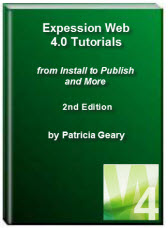- Home
- Expression Web Tutorials
- Installing Expression Web 4
- Setting Up Expression Web 4.0
- Create New Website
- Create a Blank Web Page
- Create a Webpage Layout
- Adding Horizontal Top Navigation
- Adding Vertical Navigation
- Validating Your Pages
- Creating an Expression Web Dynamic Web Template
- Publishing Your Web Site
- How to back up your local website on your hard drive
- SEO Checker and Report
- Adding Insert Include Code into Code Snippets
- Auto Thumbnail in Expression Web
- Broken Dynamic Web Templates and hidden metadata files
- Code Snippets in Expression Web
- Compatibility Checker on Status Bar in Expression Web
- Create and Style a Data Table
- Creating a New Font Family Group
- Creating a New Page from Hyperlink Properties
- Creating web site from site templates in Expression Web
- CSS Properties panel
- Expression Web Preview in Browser
- Expression Web and Design Time Includes
- How to back up your local website on your hard drive
- How to create a Personal Web Package
- Import Site Wizard in Expression Web
- Importing your folders/files into Expression Web
- Inserting Images in Expression Web
- Interactive Buttons in Expression Web
- Migrating a FrontPage Site to Expression Web
- Modify Style Dialog Box
- New Style Dialog Box
- Publishing Your Website from the Remote Server with FrontPage Server Extensions
- Editing Reusable Forms
- Troubleshooting Image Problems in Expression Web
- Validation Error - no attribute "xmlns:v"
- Web Album Generator and Expression Web
- What are all the style# in my page?
- Zoom Search and Expression Web
- Working With Left Border Background Images
- Resources
- Templates
- Web Design Tutorials
- Accessible Forms
- Add a Search Box
- Adding Google Search
- Accessible Data and Layout Tables
- Responsive Tables
- Anchor Tags and Name Attributes
- Best Font Size for Web Design?
- Center Page in Browser Window
- HTML Lists
- How to create and extract a Zip File in Windows
- How to Create a Self-Extracting Zip File
- Validation Error - no attribute "xmlns:v"
- Working With Left Border Background Images
- Handle Background Transparency in Snagit Editor Like You Would in Photoshop
- Bluehost Tutorials
- Add-on Domains at BlueHost
- BlueHost 301 Redirects
- BlueHost Webmail
- Customizing BlueHost Error Pages
- How to make a subfolder the main folder for your BlueHost main domain
- How to change the Primary Domain
- Installing a WordPress Blog Using Simple Scripts
- Mannaging SSL on BH
- Password Protecting Directories and/or Files with Bluehost
- Server Side Includes, BlueHost, and Expression Web
- Expression Web Addins

CSS Properties panel
You can use the CSS Properties panel in tandem with an open web page, external CSS file, or with the Manage Styles panel to review and change the properties and values of existing styles. I prefer working with the CSS Properties panel as it allows me to use css shorthand in writing the style rules.
If you have a web page open in Expression Web, the CSS Properties panel lets you quickly see all of the styles that the current selection in your web page uses, the order of precedence of those styles, and all of the properties and values of those styles.
On this page for example, the screenshot shows the body element selected. The CSS Properties panel shows all of the rules in the 'Applied Rules' section from the stylesheet that apply to this particular selection. The rules show in the order that they apply.

Click thumbnail for larger image
CSS Properties Panel
| 1 | The Show categorized list button
The Show alphabetized list button The Show set properties on top button |
| 2 |
The Summary button lists together, under the CSS Properties column, all of the properties that affect the current selection, instead of only the properties of a selected style. In summary mode, you can click a property under CSS Properties to outline the associated rule under Applied Rules. To get out of summary mode, click Summary again or click a rule under Applied Rules. |
| 3 |
Applied Rules lists the selector of each style that
affects the current selection. Styles are listed in ascending order of precedence,
from lowest precedence at the top of the list to highest precedence at the
bottom. |
| 4 |
This column lists the tag to which each style is applied and the selector of the style. Point at a row in this column to see the applied rule. The column is labeled Current Page when the selected style resides in an internal CSS or labeled with the name of an external CSS file when the selected style resides in an external CSS. You can point at the external CSS file name to see the path to the file or click the external CSS file name to open the file. |
| 5 | CSS Properties lists the values of properties you've set in the style selected under Applied Rules and also all unset properties. Double-click a property to go to the code of that rule set. |
| 6 | When the Show categorized list button
|
| 7 | You can set the value of a property by, in the box next to the property
name, typing a value or pointing at the box and then clicking, when available,
the drop-down arrow
|
| 8 | Properties that have a red line through them are set by the selected
style but either aren't inherited by the current selection or are overridden
by another style. To see a ScreenTip that provides more information, point
at a crossed-out property. The ScreenTip for overridden properties identifies
the overriding property. Tip: In the CSS Properties panel, to display a shortcut menu that contains additional options for working with your CSS, right-click a selector under Applied Rules. |
To modify a style by using the CSS Properties panel
You have created your site using one of the default templates that came with Expression Web. Now you would like to make some changes to the style rules in the style sheet. Using the organization 3 site we created in the tutorial Creating web site from site templates in Expression Web
Step 1: Open a web page that uses the style that you want to modify.
Step 2: In the CSS Properties panel, if the style that you want to modify doesn't appear in the Applied Rules list, put your cursor in content or select content that uses the style that you want to modify.
Step 3: In the Applied Rules list, click the name of the style that you want to modify. Example: click body under the Applied Rules list.
Step 4: In the CSS Properties section of the
CSS Properties panel, set the properties you want.
Example: Click the drop-down next to font-family and select the font-family
you wish to use. In this case, I chose a custom font-family I had added consisting
of Tahoma, Helvetica, Arial, sans-serif.
If you need instructions on how to add new font families, you can follow this tutorial Creating a New Font Family Group in Expression Web.

Copyright © Pat Geary of
Expression Web Tutorials and Templates
Published May, 2010
Expression Web 4.0 Tutorials 2nd Edition from Install to Publish, a FREE EBook by Pat Geary.
Expression Web has a group on Facebook. If you are a FB user, come join us.
Disclosure: This is an affiliate link, which means that if you visit Bluehost.com through this link and purchase this product, I’ll get a commission.

April 2007 - April 2013
Privacy Policy | Migrating from FrontPage to Expression Web
Microsoft® and Expression Web® are registered trademarks of Microsoft® Corporation.
Site Design & Maintenance : Expression Web Tutorials & Templates


